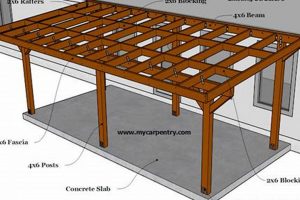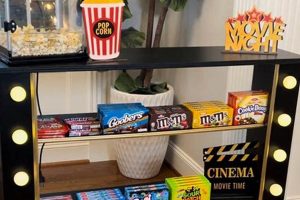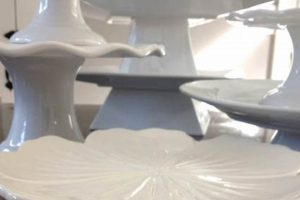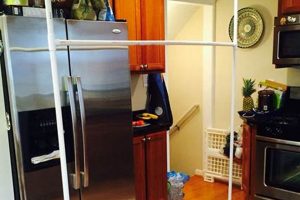The focal point involves the creation of elevated platforms designed for presenting baked goods, utilizing affordable materials sourced from discount retail outlets. These platforms are typically constructed by adhering decorative plates to supportive bases, such as candlestick holders or small bowls, acquired at minimal cost.
Engaging in such crafting endeavors offers a cost-effective alternative to purchasing commercially manufactured serving ware. It allows for customization to suit specific aesthetic preferences or event themes. Furthermore, repurposing inexpensive items promotes resourcefulness and reduces consumer waste.
This exploration delves into various techniques for constructing these platforms, highlighting material selection, adhesive considerations, and potential decorative embellishments. The subsequent sections will detail practical methods and creative inspiration for achieving visually appealing and functional results.
Crafting Cake Stands from Discount Retailers
The following guidelines facilitate the construction of stable and aesthetically pleasing elevated platforms for showcasing baked goods, utilizing components from budget-conscious retailers.
Tip 1: Adhesive Selection: Employ a strong, multi-surface adhesive specifically designed for bonding dissimilar materials such as glass, ceramic, and metal. Epoxy resins or specialized craft adhesives are recommended to ensure a durable and lasting bond.
Tip 2: Surface Preparation: Prior to bonding, thoroughly clean all surfaces with isopropyl alcohol to remove any grease, oils, or debris. Roughening smooth surfaces with fine-grit sandpaper can further enhance adhesion.
Tip 3: Weight Distribution: When selecting components, consider the anticipated weight of the baked goods to be displayed. Opt for bases with a wider footprint and plates constructed from sturdier materials to prevent instability or collapse.
Tip 4: Centering and Alignment: Exercise precision when aligning the plate and base during the bonding process. Employ a level to ensure the plate is perfectly horizontal and centered on the base, resulting in a professional appearance.
Tip 5: Curing Time: Allow the adhesive to cure completely according to the manufacturer’s instructions before placing any weight on the platform. Premature use can compromise the bond and lead to structural failure.
Tip 6: Decorative Embellishments: Enhance the visual appeal by incorporating paint, ribbon, or other decorative elements to personalize the creation. Ensure any embellishments are securely attached and non-toxic if they come into contact with food.
These recommendations emphasize structural integrity and aesthetic refinement. Adhering to these guidelines ensures the creation of a functional and visually appealing platform for presenting baked creations, all while maintaining budgetary prudence.
The subsequent section will explore advanced techniques and design considerations for elevating the creative potential of these crafted display pieces.
1. Adhesive Bond Strength
Adhesive bond strength constitutes a critical parameter in the successful construction of elevated display platforms utilizing budget-conscious retail materials. Its integrity directly correlates to the structure’s ability to support the intended load and withstand environmental stressors. The following details articulate key facets of adhesive performance in this application.
- Material Compatibility
Effective adhesion necessitates compatibility between the selected adhesive and the constituent materials of the plate and base. Many discount retailers offer items constructed from glass, ceramic, plastic, or metal. Selecting an adhesive formulated for multi-material bonding is crucial to achieve optimal strength. Failure to consider material compatibility can result in weak bonds and structural failure under load.
- Surface Preparation Influence
Surface preparation significantly impacts adhesive bond strength. Contaminants such as grease, oil, or loose particles impede adhesion. Proper cleaning with solvents and abrasion to increase surface area promotes a stronger bond. Inadequate surface preparation undermines the adhesive’s ability to effectively bind the materials, leading to reduced load-bearing capacity.
- Curing Process Adherence
Adhesive manufacturers specify precise curing times and conditions to achieve optimal bond strength. Premature loading or exposure to adverse temperatures during the curing process can compromise the adhesive’s structural integrity. Strict adherence to the manufacturer’s instructions is essential for maximizing bond strength and ensuring long-term structural stability.
- Load Distribution Considerations
The adhesive joint must be capable of distributing the load evenly across the bonded surfaces. Uneven load distribution concentrates stress on specific areas, potentially leading to premature failure. Designing the joint with a sufficient bonding area and utilizing adhesives with high shear and tensile strength minimizes stress concentrations and enhances overall structural reliability.
These considerations underscore the critical role of adhesive bond strength in the creation of stable and reliable display platforms from discount retail components. Prioritizing material compatibility, meticulous surface preparation, adherence to curing protocols, and attention to load distribution ensures a structurally sound outcome, mitigating the risk of catastrophic failure and maximizing the longevity of the creation.
2. Material Cost Efficiency
Material cost efficiency is a foundational element of the elevated display platform concept constructed from items procured at discount retailers. The inherent value proposition derives from substituting high-priced, commercially manufactured serving ware with an economical alternative. The success of this strategy hinges upon maximizing functionality and aesthetic appeal while minimizing expenditure on component materials. Instances of crafting functional platforms using inexpensive plates, candle holders, and adhesives purchased at dollar stores exemplify the practical manifestation of material cost efficiency. The ability to create a visually presentable display piece for a fraction of the retail price highlights the importance of this principle.
The application of material cost efficiency extends beyond mere economic savings. Resourcefulness in selecting and repurposing items fosters a culture of mindful consumption. For example, utilizing mismatched yet visually complementary plates and bases from discount bins not only reduces material costs but also promotes creative problem-solving. The implementation of this principle translates to tangible benefits for individuals seeking budget-friendly solutions for event hosting, home dcor, or artisanal craft ventures. This, in turn, broadens accessibility to aesthetically pleasing presentation methods, regardless of budgetary constraints.
In summary, material cost efficiency represents a crucial driving force behind this particular construction approach. It directly influences affordability, accessibility, and creative potential. While challenges may arise in sourcing suitable components or balancing cost with durability, the overall emphasis on minimizing material expenditure remains paramount. The understanding and application of this principle are essential for those seeking to create functional and visually appealing elevated platforms without incurring significant financial investment.
3. Structural Base Stability
Structural base stability represents a critical determinant of the functional integrity and safety of elevated display platforms constructed from materials sourced at discount retailers. The foundation bears the load, and its design and execution directly impact the overall stability and reliability of the complete structure.
- Material Selection for Load Capacity
The material composition of the base directly influences its capacity to support the weight of the plate and any items placed upon it. Lightweight plastics or thin glass may exhibit insufficient rigidity, leading to deformation or catastrophic failure under load. Opting for bases constructed from sturdier materials, such as solid ceramic or thicker metal, enhances load-bearing capabilities and minimizes the risk of instability. A ceramic candle holder, for example, will generally provide more inherent structural stability than a plastic bowl of similar dimensions.
- Geometric Design and Footprint
The geometric configuration of the base influences its stability and resistance to tipping. A wide footprint provides a lower center of gravity and increased resistance to lateral forces. Narrow bases, particularly those with a high center of gravity, are inherently more susceptible to toppling. A wider, more substantial base design mitigates this risk and provides a more secure foundation. For example, a pedestal with a wide, flat base is preferable to one with slender legs.
- Adhesive Joint Integrity at the Base
The adhesive bond between the base and the display surface is a critical point of structural vulnerability. The strength and durability of this bond directly affect the overall stability of the assembly. Inadequate adhesion or improper surface preparation can lead to separation between the base and the supporting surface, resulting in instability or collapse. Proper cleaning of surfaces and the use of appropriate adhesives designed for the specific materials being bonded are essential for a secure connection.
- Distribution of Weight and Center of Gravity
The distribution of weight on the elevated platform affects the stability of the entire structure. Uneven weight distribution can shift the center of gravity, increasing the risk of tipping or collapse. Centering the load on the plate and using bases with a symmetrical design helps to maintain a balanced center of gravity and enhance overall stability. Placing heavier items towards the center of the platform, rather than the edges, further contributes to stability.
These considerations underscore the crucial role of structural base stability in the creation of functional and safe elevated display platforms from budget-conscious materials. Addressing these aspects of material selection, design, adhesive bonding, and load distribution ensures a more robust and reliable structure. Prioritizing structural base stability mitigates potential hazards and enhances the overall utility of the creation.
4. Plate Surface Aesthetics
The visual appeal of the plate surface constitutes a primary consideration in the creation of elevated display platforms from discount retail components. Surface characteristics influence the perceived value and desirability of the displayed items, thereby affecting the overall success of the presentation.
- Color Palette Coordination
The plate’s color scheme should complement the baked goods or other items intended for display. Harmonious color pairings enhance visual appeal, while clashing colors detract from the presentation. For example, a white plate provides a neutral backdrop for colorful pastries, whereas a patterned plate may better suit a simpler confection. The selection of color palette significantly impacts the perceived elegance or casualness of the setup, requiring careful consideration of the overall event aesthetic.
- Pattern and Texture Considerations
The presence of patterns or textures on the plate surface introduces visual interest but necessitates careful evaluation to avoid overpowering the displayed items. Intricate patterns may compete with complex desserts, while subtle textures can add depth and sophistication. The choice between smooth and textured surfaces depends on the desired level of visual complexity and the nature of the items being presented. Textured surfaces can also offer functional benefits, such as preventing items from sliding.
- Material Sheen and Reflectivity
The surface sheen of the plate influences how light interacts with the displayed items and the surrounding environment. Highly reflective surfaces can create glare and distort the appearance of the food, while matte surfaces offer a more subdued and natural presentation. The selection of sheen should align with the lighting conditions and the desired level of formality. For instance, a glossy surface may be suitable for a brightly lit buffet, whereas a matte finish may be preferable for a dimly lit dinner setting.
- Edge Detailing and Finishing
The design and finishing of the plate’s edge contribute to its overall aesthetic appeal and perceived quality. Simple, clean edges convey a modern aesthetic, while ornate or scalloped edges evoke a more traditional style. Imperfections or chips along the edge detract from the presentation and may raise concerns about hygiene. Careful inspection of the edge detailing is crucial to ensure a polished and professional appearance.
These elements of plate surface aesthetics collectively contribute to the overall visual impact of elevated display platforms. The selection of plates from discount retailers necessitates a discerning eye and an understanding of how these characteristics interact with the displayed items and the surrounding environment. Prioritizing these aesthetic considerations enhances the perceived value and appeal of both the display platform and the items it presents.
5. Project Time Investment
The time required for a “diy dollar store cake stand” project represents a significant factor in its overall feasibility and appeal. Prolonged construction times can negate the cost savings derived from using discount materials, particularly when considering the value of an individual’s labor. Efficient project execution directly impacts the practicality of creating multiple stands for events or commercial purposes. Projects requiring extensive curing times, intricate assembly, or multiple stages of decoration inherently demand a greater time commitment, potentially diminishing their attractiveness compared to readily available, albeit more expensive, alternatives. For example, a simple cake stand constructed by adhering a plate to a candlestick with a fast-curing adhesive involves a minimal time investment, whereas a stand incorporating mosaic tile embellishments and multiple coats of sealant necessitates a significantly longer period.
The “diy dollar store cake stand” initiative hinges on time allocation efficiency. Proper planning, including pre-emptive material acquisition and a streamlined assembly process, can mitigate unnecessary delays. Selecting readily available materials and simplified designs reduces the learning curve and speeds up production. For instance, opting for a single-component adhesive over a multi-part epoxy system eliminates mixing time and simplifies the bonding process. Similarly, choosing pre-painted materials obviates the need for painting, further shortening the overall project duration. Success depends on balancing the desired aesthetic with realistic time constraints.
In conclusion, the time invested in a “diy dollar store cake stand” construction directly impacts its practicality. Efficient project management, material selection, and design simplification are crucial for maximizing the benefits of this cost-effective alternative. Failure to account for time requirements can result in projects that are ultimately more expensive and less efficient than purchasing commercially available options. Therefore, an accurate assessment and careful management of the time investment are paramount for realizing the full potential of DIY display platforms.
Frequently Asked Questions
The following addresses commonly encountered inquiries regarding the construction and utilization of elevated display platforms crafted from materials procured at discount retail establishments.
Question 1: What types of adhesives are most suitable for bonding dissimilar materials commonly found in dollar store components?
Epoxy resins, cyanoacrylate adhesives (super glue), and specialized multi-surface craft adhesives exhibit acceptable bonding characteristics for joining glass, ceramic, metal, and plastic. Thorough surface preparation, including cleaning and abrasion, is crucial for optimal adhesion.
Question 2: How can structural stability be ensured when utilizing inexpensive materials that may have inherent weaknesses?
Selecting bases with a wide footprint and a low center of gravity enhances stability. Distributing weight evenly across the plate surface and avoiding overloading the platform mitigates the risk of toppling. Reinforcing the adhesive joint with supplemental mechanical fasteners, where feasible, provides added security.
Question 3: What safety precautions should be observed when working with adhesives and potentially fragile materials?
Working in a well-ventilated area minimizes exposure to adhesive fumes. Wearing gloves protects the skin from contact with adhesives and potentially sharp edges. Eye protection safeguards against accidental splashes or flying debris. Following the manufacturer’s safety guidelines for all materials is imperative.
Question 4: How can the aesthetic appeal of a DIY dollar store cake stand be enhanced without significantly increasing the cost?
Employing decorative paint, ribbon, or embellishments adds visual interest. Coordinating the color scheme with the intended use enhances the overall presentation. Utilizing textured or patterned plates introduces visual complexity. Careful attention to detail and craftsmanship elevates the final product.
Question 5: What cleaning methods are recommended for maintaining the hygiene of a DIY dollar store cake stand used for food display?
Hand washing with warm, soapy water is generally adequate. Avoid abrasive cleaners that may damage the surface finish. Inspect the adhesive joint regularly for signs of degradation. Discard the stand if cracks or chips develop, as these can harbor bacteria.
Question 6: Are there any legal considerations regarding the use of DIY dollar store cake stands for commercial food display?
Local health codes may stipulate requirements for food-contact surfaces. Ensure that the materials used are non-toxic and food-safe. Verify that the stand is easily cleanable and does not present a risk of contamination. Consult with local health authorities to confirm compliance with all applicable regulations.
These FAQs provide guidance on constructing and utilizing elevated display platforms safely and effectively. Adherence to these recommendations promotes structural integrity, aesthetic appeal, and compliance with relevant regulations.
The following section explores potential applications and alternative designs.
Conclusion
The preceding analysis has explored the multifaceted aspects of elevated display platforms constructed from budget-conscious retail components. Structural integrity, material cost-efficiency, aesthetic considerations, and temporal investment have been examined as crucial determinants of project success. The responsible application of appropriate adhesives, meticulous surface preparation, and thoughtful design choices are paramount.
While offering an economically viable alternative to commercially manufactured serving ware, the long-term durability and potential safety implications of these projects must be carefully considered. Individuals undertaking such endeavors should prioritize adherence to best practices and a thorough understanding of material properties to mitigate risks and ensure the creation of functional and visually appropriate display pieces. The informed and judicious implementation of this approach allows for resourcefulness, customization, and aesthetic expression.







